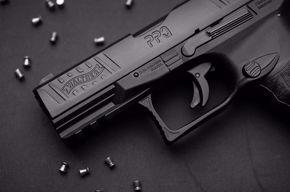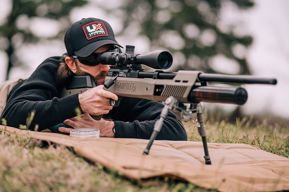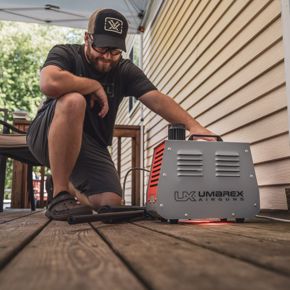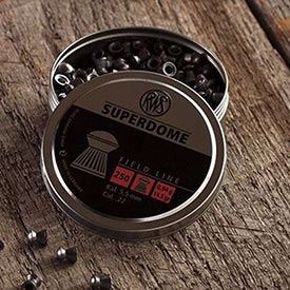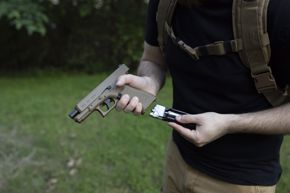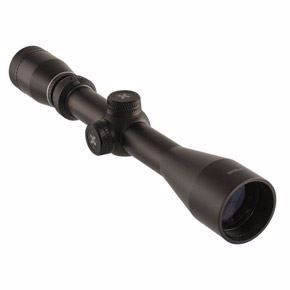In any given caliber or type of projectile launching device, there are three basic variables, the shape of the projectile, the mass of the projectile, and the force of the launch. Changing any of these variables results in different performance based upon the variable altered. The common .223 Remington cartridge is useful to demonstrate this point for all three variables.
“Standard” velocity ammo is loaded at about 3240 FPS with a 55-grain projectile. Change one variable, say the weight of the projectile to 60 grains, and velocity will drop to 3160 FPS. As a result, the muzzle energy changes somewhat as well. The 55-grain slug will generate 1124 Ft –lbs of energy while the 60-grain slug will generate 1330 ft-lbs. Velocity goes down and the energy goes up? Yes, this sometimes happens and can be explained by physics. The greater mass of the heavier projectile takes more energy to start and stop. Thus, despite being handicapped in velocity, it wins in terms of power.
If we go to a yet heavier 69-grain bullet, we still experience a reduction of velocity, but the energy developed at the muzzle doesn’t decrease. The muzzle energy manages to increase slightly even though the projectile has gained 15% in mass. The 69-grain bullet is creating 1333 ft-lbs of energy, 209 ft-lbs more than the lighter and faster 55-grain projectile. There does come a point where the weight, velocity, and energy will plateau. For this example, it seems to happen at about 69 grains of weight.
The takeaway for this lesson is that muzzle velocity is not the defining characteristic of a rifle or a pellet rifle, nor is it the end all of firearms discussions. All shooters, archers, airgun, or rifle shooters are in the same mathematical boat in terms of ballistic physics.
There are applications where speed is king, applications where bullet design reigns, and applications where energy delivered to the target trumps all. Shooters of all stripes need to take note and plan accordingly.
In the discussion above, presumably, only two variables were changed, the weight and shape of the bullet. Altering the powder charge would create a new range of outcomes for the figures given. So how does this pertain to airguns? Effectively we have only two variables to work with. A spring powered air rifle is generating the same “charge” of air with every shot. Since the air is consistent, the pellet shape and weight are the two variables we can play with.
For some shooters, all that will ever matter is the maximum velocity they can get from any air rifle or firearm. Like Nigel Tufnel in This Is Spinal Tap the ones that go to 11 are all that will ever matter. .38 Special or .357 Magnum? .357 Magnum! .30-30 Winchester or 7mm Remington Magnum- 7 Mag!!! Never mind that the .38 Special is inherently accurate or that the anemic .30-30 Winchester has taken more deer than any round ever—more “power” is all that matters to some.
Common pellet shapes have various performance characteristics. If you are going for speed and penetration, use a pointed pellet. Looking for accuracy in target shooting? The flat tipped “wad-cutter” style pellet makes scoring targets easy, as well as generating the accuracy at 10 meters to win matches. Looking for a good compromise in range, accuracy, and power? Domed pellets tend to fly good and transfer energy to a target well. There are some novelty pellet shapes on the market, but those listed constitute the basic and most popular designs.
Heavy, Man
For pellet weight, we will focus on .177 caliber for the example. .177 caliber pellets can vary from 4.5 grains to 16.2 grains. A 16.2-grain pellet is 360% heavier than a 4.5-grain pellet! Remember our example using .223 Remington? A simple change of 15% made a huge difference in power output and a significant difference in velocity. To put things into some perspective with a comparison to .223 Remington, 40-grain bullets are the lightest while the heaviest .223 bullet is around 85 grains. This calculates to about a 212% difference between the two.
How about some real world numbers? OK, here we go. We took the Umarex Forge, a non-magnum .177 caliber air rifle, to the range with every pellet we could come up with. The lightest was an RWS 4.5-grain Hyper Velocity pellet. Using the average shot velocity with that pellet, 1066 FPS, and American Airgunner’s Airgun Calculator the muzzle energy figured 11.36 ft-lbs. The heaviest .177 pellet we could come up with was 10.34-grain JSB Exact Heavy Diabolos. These pellets shot from our Forge rifle at an average of 784 FPS and 14.12 ft-lbs of energy at the muzzle. The heavier pellet shoots about 282 FPS slower than the ultralight pellet yet makes about 24% more energy at the muzzle. Interesting indeed. But let’s look into the middle, shall we?
We consider 7-grain pellets to be a standard lead pellet. Our Forge was tossing 7-grain RWS Hobby’s out of the muzzle at about 967 FPS. When run through the ballistic calculator, those 7-grain pellets are generating 14.54 ft-lbs of energy at the muzzle. This is 28% more than the speed demon 4.5-grain RWS Hyper Velocity pellets, but only 3% more than the 10.34-grain JSBs. We also shot the crowd favorite RWS Superdome’s and the new RWS Powerball’s. The Superdomes weigh in at 8.4 grains with an average velocity of 878 FPS and the Powerball’s weigh in at 9.4 grains and an average velocity of 807 FPS. In terms of power, these figures translate into 14.38 ft-lbs for the Superdome’s and 13.6 ft-lbs for the Powerball’s.
So the clear winner in the horsepower war for this air rifle is the RWS 7 grain Hobby pellet. But is that the whole story? Remember pellet shape? We are going to test these same pellets at two distances, 10 yards and 25 yards for accuracy. Will the 7 grain be on top still at 10 yards? 25 yards?
Accuracy
As it turns out, once again no big surprises with accuracy when you stay in the happy middle. At 10 yards all of the pellets in the 7-10.34 grain range shot admirably. All groups were between .20” to .375”center to center. We didn’t have anything heavier than 10.34 grains so we can’t speak to those pellets in this gun, but we did shoot the 4.5-grain RWS Hyper Velocity pellets. At 10 yards the super lightweight pellets were grouping at .69”. This is quite a bit larger than the standard pellets were grouping. At that range, these would be fine for plinking or pest control.
When we stretched things out to 25 yards the trends we noticed above bore out. But we can’t just put in a big ditto mark on the page and go on so here are the details. The best group was the 8.4-grain RWS Superdome. These came in at a respectable .55” group. The 7-grain RWS Hobby Pellets were next at .625” and the RWS Powerball and JSB 10.34 grain pellets were coming in at .69”. Any of these would be accurate enough for hunting, target, or plinking at this range and perhaps further. Unfortunately the speedy 4.5 grain RWS Hyper Velocity was not able to deliver good accuracy at this range for this rifle. These pellets grouped at 2.25” at 25 yards. We could still knock around tin cans out to 25 yards with this rifle/pellet combination, but we wouldn’t hunt or compete in a target match with it.
As it is in many areas of life, so it is with pellets. Avoiding excesses and extremes is pretty safe ground to stand on. It may not be the most interesting, newest, or most hyped, but “safe middle” tends to be the best place to tread. A good way to find a pellet that your air rifle likes and that you like is to buy a sampler pack. This can save you some heartache and money as you’ll have plenty of pellets to experiment with to determine what you want to buy in larger quantities. RWS has a 5 pellet sampler that is perfect for dialing in your .177 caliber rifle. Order some of these today so you’ll be ready to go shooting next weekend.
Mark Davis, avid outdoorsman and family man, is the Social Media Specialist at Umarex USA.

